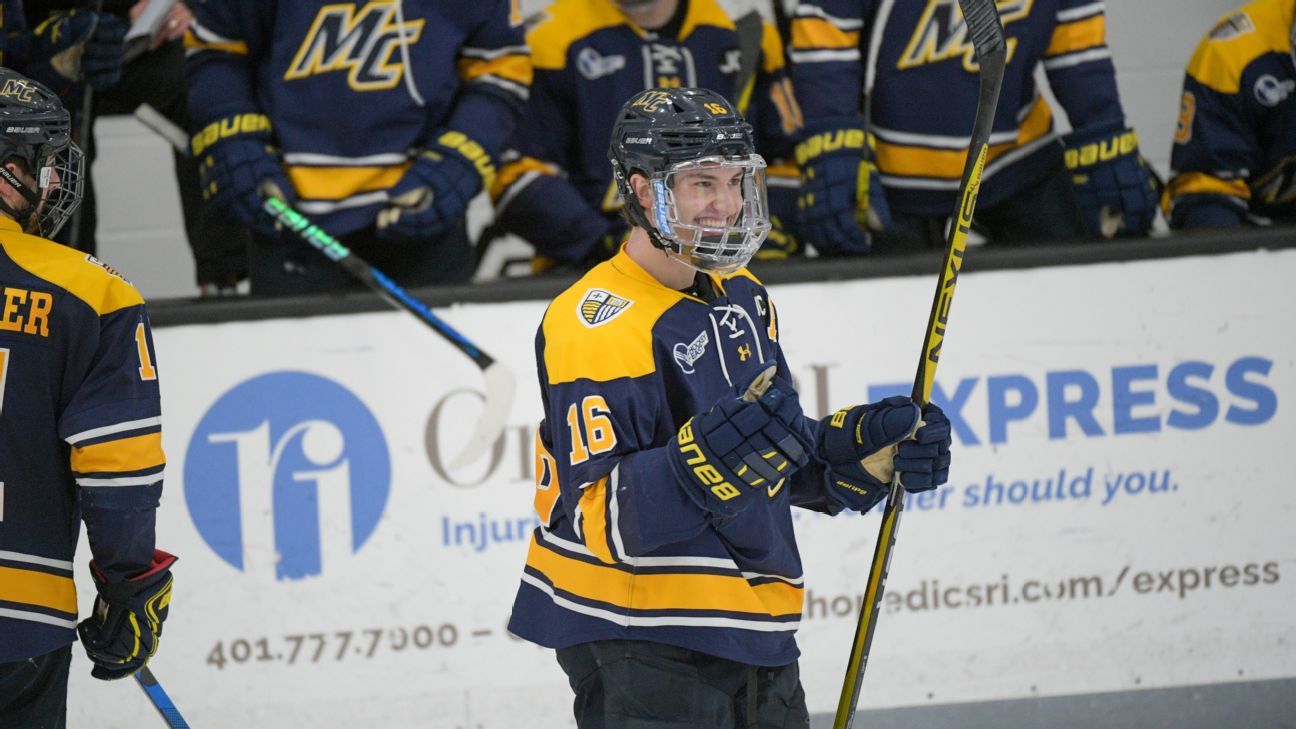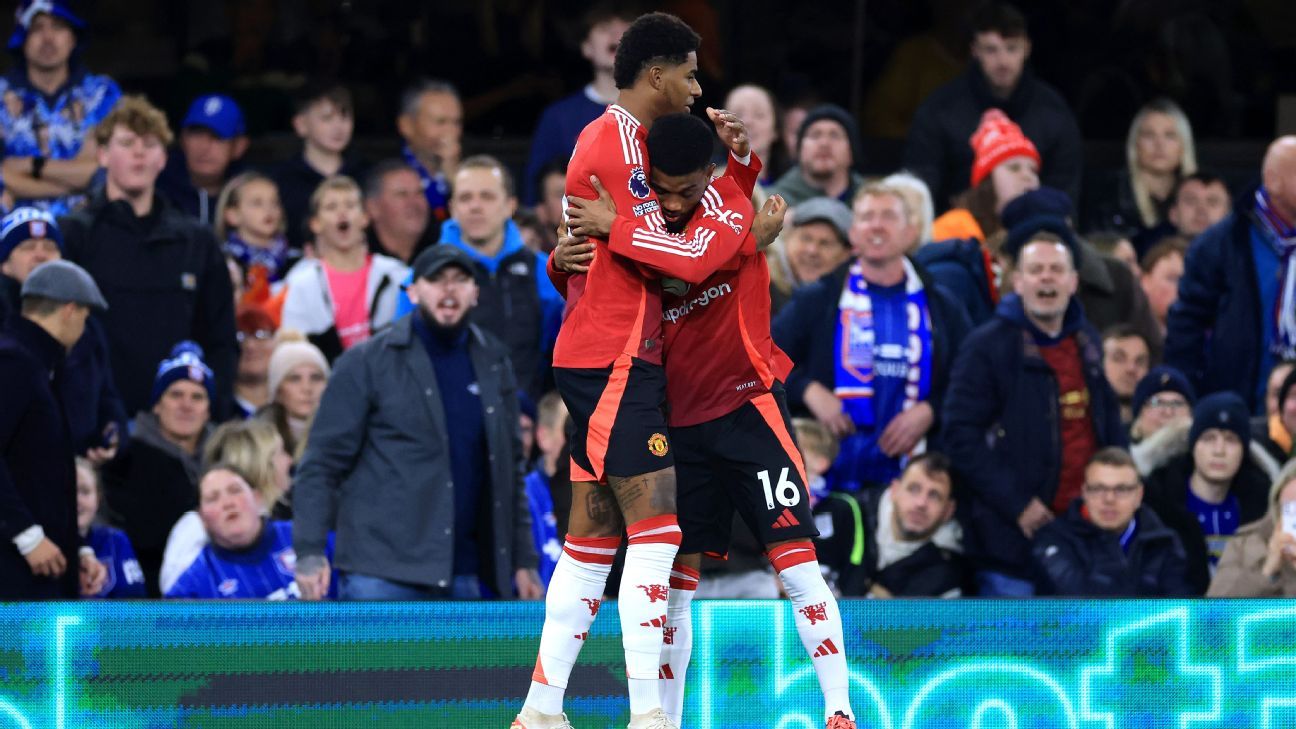
With holiday breaks and midseason tournaments in the rearview mirror, college hockey season is about to hit its stride. Focus turns to the conference races, and in the not-too-distant future, the NCAA tournament.
A good number of the traditional powers sit at the top of the college hockey heap, including defending national champ Denver, fellow 2022 Frozen Four teams Minnesota and Michigan, and resurgent teams such as St. Cloud State and Boston University. But there are some surprises up there as well, including Penn State and Merrimack.
There will be plenty of jockeying in the league standings before conference tournaments begin at the start of March. Then comes selection day for the men's NCAA tournament March 19, culminating with the Frozen Four on April 6 and April 8 in Tampa, Florida.
As the conference races heat up, we asked college hockey analysts Colby Cohen, Andrew Raycroft and Sean Ritchlin, and ESPN hockey reporter Ryan S. Clark about what they've seen so far and what they're looking forward to in the second half of the season, including the biggest surprises, most intriguing races, top players and who will make it to Tampa.
Dozens of men's college hockey games, including games from Hockey East and the ECAC, are available to stream on . Subscribe here.
What team has been the biggest surprise so far this season?
Cohen: Merrimack. It's great to see Scott Borek leading the Warriors to a successful season in a difficult conference in Hockey East. They have some guys having great statistical years, but the way they have defended and played physical hockey have made it very challenging for teams to compete against for three periods. It also never hurts when you have a guy like Alex Jeffries, who is clicking in at more than a point a game. It will be really interesting to see if Merrimack can keep this going.
Ritchlin: I agree, it's Merrimack. The Warriors are 9-2 in Hockey East through the first half of the season and 14-6-1 overall, and are 10th in the PairWise rankings. Jeffries (1.19 points per game) leads the offense, but the key is that they play a hard team game and do not give up much. It's been quite a turnaround from 2020-21, when they had only five wins all season.
Raycroft: Add me to the Merrimack crowd. Gathering motivation from the passing of assistant coach Josh Ciocco, the Warriors are the story of the season. They lead Hockey East with 27 points in 11 games, yet they've finished higher than sixth in the league just once in the last 10 years and haven't made the NCAA tournament since 2010.
Clark: Alaska Fairbanks. The Nanooks just split a two-game series against defending national champion Denver, a top-three team. They also have a win over Notre Dame and lost a pair of one-goal games to Penn State, another top-five team. After being left out of the WCHA realignment, then missing the 2020-21 season entirely, Alaska Fairbanks struggled last season but is up to 21st in PairWise and has been one of the more interesting teams in college hockey.
What league race do you expect to be most intriguing the rest of the way?
Ritchlin: Hockey East will be the most intriguing with the traditional powers all looking up at Merrimack. BU and Northeastern seem poised to be strong contenders for the top spot, but there are six or seven teams that could claim the title. It should be a highly competitive second half.
Raycroft: The CCHA will be closely contested down the stretch, but with the emergence of Merrimack and UConn, Hockey East will be the race I'm watching the closest. As of Jan. 9, there are seven Hockey East teams in the PairWise top 25.
Clark: It might be the CCHA. The race is tight given Minnesota State, Bowling Green, Michigan Tech and Bemidji State are separated by five points. Now consider where those teams sit in the PairWise -- Michigan Tech is 13th, Minnesota State is 18th, Bemidji State is 22nd, Bowling Green is 29th. The CCHA looking like it might be a one-bid league in terms of the NCAAs will make the finish even more interesting with the realization it could be a long offseason for whoever misses out.
Cohen: I have to say Hockey East. There seems to be a number of teams that are circling around and could have a great second half. This is where good teams really separate themselves. Boston College has been playing better as of late, BU has been very solid all season except for a few hiccups, and UConn and Northeastern both look to be solid teams. But, of course, they are all chasing down Merrimack.
Who are the front-runners for the Hobey Baker Award?
Ritchlin: Freshman Ryan McAllister has been dominant at Western Michigan with 38 points, averaging 1.73 points per game. He has made a great transition from junior hockey to college. The question will be if he can keep it up at the same pace for the second half of the season. McAllister's senior linemate Jason Polin, with 19 goals in 22 games, also is a strong candidate. Other names to keep an eye on in the second half are Michigan freshman Adam Fantilli, Minnesota defenseman Brock Faber, Bowling Green's Austen Swankler, Northeastern's Aidan McDonough and Quinnipiac's Colin Graf.
Raycroft: The Hobey Baker race is wide open, but I expect sophomore defenseman Luke Hughes, the No. 4 pick in the 2021 NHL draft, to have a monster second half for Michigan and win the award. St. Cloud senior defenseman Dylan Anhorn, Northeastern goalie Devon Levi, Harvard's Sean Farrell, Denver's Carter Mazur and Fantilli will all be in the mix.
Cohen: It looks to be the year of the underclassman, so while Jason Polin's five hat tricks and 19 goals in 22 games for Western Michigan are impressive, my defenseman bias kicks in here and I have to say Luke Hughes for Michigan. His ability to control a game from the back end by distributing the puck or using his smooth strides to skate it in himself makes him a threat every time he climbs over the boards. Coming off a strong World Juniors tournament, I also expect Hughes to have a big second half, taking a run at Tampa before donning that red New Jersey Devils logo down the stretch.
Clark: There are a number of options. Ryan McAllister and Jason Polin of Western Michigan and Quinnipiac goalie Yaniv Perets (1.63 GAA) are off to great starts and are examples of undrafted players who can't be ignored. But we've seen plenty of Hobey winners who have come on strong in the second half, so it's worth keeping an eye on NHL draft picks Fantilli, Hughes, Mazur, Minnesota freshmen Logan Cooley and Jimmy Snuggerud.
Who is your favorite player to watch?
Raycroft: Adam Fantilli, the projected No. 2 overall pick in the 2023 NHL draft, has been electric since day one at Michigan. With 26 points in just 16 games, he is must watch during his last few months as a collegian before taking the next step.
Ritchlin: At 6-foot-3, 210 pounds, Minnesota forward Matthew Knies is a true power forward. He has great balance down low while protecting the puck and has the speed to get to the net from the corners, which combined with his size creates massive issues for opposing defensemen. He may be the most NHL-ready forward in college hockey.
Clark: Luke Hughes. College hockey has become an incubator for puck-moving defensemen who become instant NHL contributors. We've seen it with Norris winners Adam Fox and Cale Makar, along with the likes of Quinn Hughes, Charlie McAvoy, Owen Power and Zach Werenski. Michigan's Hughes looks like he has everything needed to be the next one off that assembly line.
Cohen: Domenick Fensore. The BU captain has been dominant most nights for the Terriers, starting the second half with an overtime game-winning goal against Harvard in a top-10 matchup. BU leans on Fensore for leadership off and on the ice, where he logs upward of 30 minutes a night. His offensive poise along the blue line and his ability to make plays out of nothing make him exciting to watch every time he has the puck on his stick.
Who are your picks to make the Frozen Four?
Cohen: Denver, Minnesota, Michigan Boston University. The blue bloods are back in a big way this season. Denver has continued its success under David Carle with many key returners from last year's national championship team. Michigan is loaded with talent, and added experience after last year's Frozen Four trip. Minnesota is loaded top to bottom, and with Matthew Knies leading the way, I think the Gophers have as good a chance as anyone. Last but not least, BU will return to the Frozen Four after a few bumpy seasons, with first-year coach Jay Pandolfo and star goaltender Drew Commesso leading the way.
Ritchlin: Denver, Minnesota, St. Cloud, Quinnipiac. Denver has picked up right where it left off after winning it all last season and plays a confident, responsible 200-foot game that is very effective in the NCAA tournament. Minnesota is loaded with talent on both sides of the puck and the Gophers are very difficult to contain once they get going. St. Cloud State is well coached and balanced throughout its lineup with a ton of tourney experience. Quinnipiac, with only one loss this season, is a stingy team that made the regional finals last year.
Raycroft: Denver, Minnesota, Michigan, Boston University. All four programs have experienced, big-game goaltenders and top-end talent up front. Denver is my favorite to repeat because of its commitment to a two-way game and understanding what is necessary to get through the tourney. Minnesota has the most talented roster. Michigan's returning players gained an understanding of what it takes to win in the tourney and Fantilli can be a game breaker. BU might be a little small on the back end, but Commesso can win any game. I believe the Terriers' coaching staff has the ability to make the correct adjustments come the regionals.
Clark: Denver, Michigan, Minnesota, Penn State. Denver has the experience of both winning a national title and understanding what it means to be defensively restrictive. Michigan and Minnesota might be the two most talented teams in the nation, which could prove vital against systems that try to take away time and space. Penn State has been strong all year. Earlier this season, it played four straight games against Michigan and Minnesota and had a chance to win all four, taking two and forcing overtime in another.















 Phone: (800) 737. 6040
Phone: (800) 737. 6040 Fax: (800) 825 5558
Fax: (800) 825 5558 Website:
Website:  Email:
Email: 






